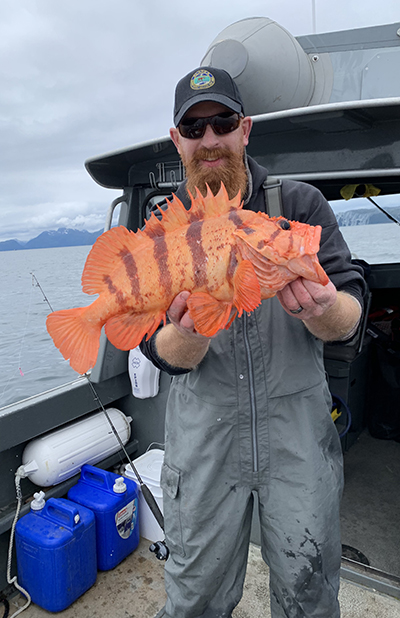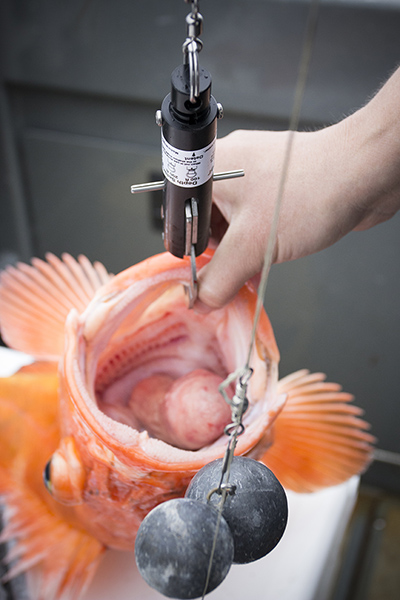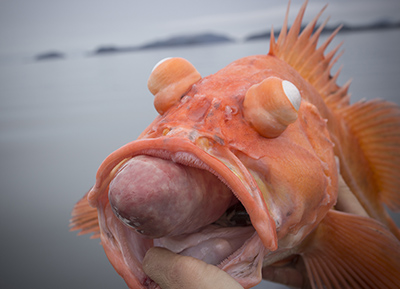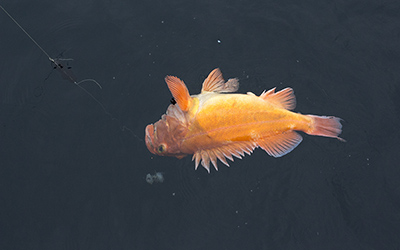Alaska Fish & Wildlife News
June 2024
Why Rockfish Matter

We motored slowly toward a dark rock outcropping flecked by large hemlock trees on the bank that were no more than 40 feet away from the bow of the boat. The sky was open and blue, the water calm but undulating with minor swells; a rare day for me, at least in my experience out in Prince William Sound. I scanned the fish finder one more time and was awed at the abrupt depth from shoreline to seafloor – 120 feet. A few pixilated forms held council just above the jagged substrate dotted here and there across the screen.
I stepped out of the wheelhouse and took a stance port side, picked up my rod, and swung the two-hook rig of shrimp flies tipped with a small piece of herring over the gunnel. For a moment the 8-ounce weight bobbed gently on the surface. I freed the spool of the reel and let gravity do what it does. I watched the line peel away, thumbed the spool lightly, felt the line go slack when the weight hit the bottom. I took a couple cranks of the handle to sustain the weight just above the rocky depths. And in no time, I felt the telltale tap-tap pulse through the rod. I set the hook, and began reeling in, careful to keep the line tight as I worked the fish through the water column.
This spot was chosen at random using electronics. We were on our way back to port, having caught a solid number of various rockfish species that day. This spot looked good: structure, peaks, valleys, and a steep drop off, solid rockfish habitat spiring up beneath gentle waves near an unassuming wall of rock onshore; located in a tight passage between an island and the mainland in western Prince William Sound. I was on the ADF&G research vessel Standard Error with my two of my colleagues who were out gathering information about rockfish, more details on that to come. This would be our last stop of the day and my last fish of the day.
Rockfish are some of the most beautiful and colorful saltwater fish you’ll find in Alaska. Some are a brilliant shade of orange. Some display yellow, red and pink hues so prodigious they look more like a tropical fish than something you’d find in the cold, dark waters of the north. My personal favorite, the tiger rockfish, wears a coat of faded peach elegantly marred with precisely seven maroon bands draped vertically from head to tail. Look into the eye of a China rockfish and you’ll see a blue so vibrant you’ll be left to wonder: Why? And for each colorful beauty, there are others that wear mottled brown and tan desert drab like outstanding camouflage in a rock garden. Some display dark grays, dull blacks, muted blues, as if having chosen function over fashion.
The fish made it to the surface. A tiger rockfish, the first one of its kind for me. Up until then I’d only seen this species in photographs. I studied it as it lay motionless on the surface. It wasn’t dead, just bloated, in a sense, taut with gases, unable to vacate the pressure that was built up inside its body. This can happen to rockfish because of their body structure. The changes in pressure from being pulled from the ocean depths to the surface cause a rapid expansion of gases inside the fish. The fish doesn’t have a way to deflate itself because of a closed swim bladder system, so their body bulges. Sometimes the eyes pop out. The stomach protrudes from the mouth like an inflated cartoon tongue. It’s called barotrauma and it looks hideous, but the fish is still alive.

If you unhook the fish and toss it back, chances are it’ll float on the surface because the gases in its body have it puffed up like a party balloon. It can’t swim back down on its own with all this trapped air. Think of it this way: if someone dropped a box with a hundred-dollar bill in it at the bottom on a 12-foot-deep pond and they say you can have the money if you can retrieve it. The only caveat is you must wear a life jacket. Try swimming down to grab the cash. Short of someone tossing you an anchor heavy enough to sink you, you’re not going to get the cash.
A Moral Dilemma and Taking Action
There are close to 40 different species of rockfish in Alaska. In my opinion, rockfish are an extremely fascinating species of fish. Some species can be found hanging out close to the bottom, while other species tend to ride higher in the water column; they are separated in groups depending on the habitat they live in. I’ve seen rockfish pulled in from a depth of over 800 feet in Prince William Sound, and I’ve seen young kids catching rockfish from a dock in Sitka.
Of particular interest to me is the fact that some species of rockfish can live to be well over 100 years old. It baffles me to think that right now, there’s a rockfish swimming around that was alive when the Titanic sank. To think that a fish that was alive during the Great Depression could end up getting caught, filleted, and turned into tacos presents a bit of a moral dilemma for me. Why wrap history in a tortilla?
Admittedly, it’s taken a good bit of education and experience for me to even espouse my moral rockfish dilemma. I’ve harvested my fair share of rockfish. They make great table fare. And the truth is, not all rockfish that come over the rail are upwards of 100 years old. But some are. Or they could be. And it depends on the species. It’s not like I can tell the age of a fish just by looking at it. For that, the fish would have to be harvested and the otoliths pulled from its skull. Those otoliths would then need to be sent to a lab and prepared by a scientist for further examination. Otoliths are the ear bones of the fish. Otoliths allow the fish to hear and sense vibrations in the water. They also never stop growing throughout the life of the fish.
These otoliths develop concentric rings annually. Much like a tree. And when prepared and examined under a microscope, a trained eye can count the rings and determine the age of the fish; this process is incredible. And it’s allowed people to gain a far greater understanding of the life history of these fish and the ages that compile different populations.
I recently worked with a few staff members from Southeast Alaska to develop an otolith display poster. This display uses one rockfish. One. A yelloweye caught incidentally in the frigid waters of Southeast Alaska in 2021. The fish was aged at 121 years, it wasn’t even that big: 15 pounds, 29 inches in length. I have seen yelloweye bigger than that get caught; I oversee the ADF&G Trophy Fish Program and have processed entries for yelloweye rockfish measuring well over 30 inches and pushing 30 pounds. How old are those fish, I often wonder; but I’ll likely never know.

ADF&G has staff on many Alaskan harbor docks that collect samples from sport and commercial fishers. If you return to port with fish you’ve harvested, please take a minute to allow our port/creel samplers to take samples from your fish. What they do, and what we learn from these samples contributes to our understanding of populations and our fisheries. This information is integral for our management and sustainability of these fisheries.
I digress.
I’m not opposed to anglers doing what they can legally do when it comes to the retention of rockfish. In many areas of the state, rockfish can be harvested by anglers, following daily bag and possession limits outlined in the Sport Fishing Regulations. In some parts of the state, certain species such as yelloweye rockfish cannot be retained because of conservation concerns. In other areas, daily bag and possession limits of rockfish have been reduced by emergency order. If you have questions about sport fishing regulations as they relate to rockfish, call the ADF&G office in the area you plan to fish. These are efforts aimed at protecting these important fish. With a fish species that is slow growing, slow to reach spawning maturity, and very susceptible to being overharvested, if we do not take proactive measures now to help keep these fish around, we’ll likely see major declines in populations in the future.
I may not have a degree in biology, but I’ve seen enough in my personal and professional life to know that the resources we have access to in Alaska’s waters simply cannot be found anywhere else in the world. Anyone who’s fished here can understand that. And that is one of the many reasons why doing our part to protect and improve what we have is so crucial for future generations.
I’ve had the privilege to be part of an ongoing effort within the Alaska Department of Fish and Game to help educate anglers and the public about rockfish, to help conserve the species for future generations, and to build a great knowledge and biological understanding of rockfish. The effort I’m referring to is known as the Statewide Rockfish Initiative (SRI). Much information about the purpose and focus can be shared on the SRI. In short, “The SRI is working to develop stock assessments for black and yelloweye rockfish in parts of Alaska, conducting research on black rockfish abundance in Kodiak, mapping yelloweye rockfish habitat in Southeast Alaska, and analyzing black and yelloweye rockfish genetics. The SRI is also sharing information with the public about rockfish identification and life history. This is to educate the public about the importance of taking action now to sustain future rockfish populations. Rockfish conservation is a collective effort, and what we do now matters.” If you’d like to learn more, click here: Statewide Rockfish Initiative.
How to Save a Rockfish
Back to barotrauma.
Look at the yelloweye rockfish in the photo. That fish was caught in around 250 feet of water. The picture was taken on May 10, 2018. That’s six years ago, at the time this article was first written. We were out in Prince William Sound conducting research on rockfish. This fish, along with several others that day, was released back to the depth it was caught using a deepwater release mechanism. I’d bet good money that fish – to this day – is still alive. Unless of course someone (or something) else caught it and ate it.
That fish was caught in around 250 feet of water. The picture was taken on May 10, 2018. That’s six years ago, at the time this article was first written. We were out in Prince William Sound conducting research on rockfish. This fish, along with several others that day, was released back to the depth it was caught using a deepwater release mechanism. I’d bet good money that fish – to this day – is still alive. Unless of course someone (or something) else caught it and ate it.

One study conducted by ADF&G showed yelloweye rockfish caught and released back to depth of capture using a deepwater release mechanism had a 98% chance of survival. What’s the chance of survival if released at the surface and left to float? Very low for certain rockfish species, especially yelloweye rockfish. The fish will float around, unable to resubmerge on its own, and eventually will be eaten by birds or marine mammals or succumb to thermal exposure. What happens, then, when a rockfish with barotrauma is released using a deepwater release mechanism back to the depth it was caught at?
We attached a GoPro to a SeaQualizer, which is a type of deepwater release device, and have released hundreds of fish just to see what happens as they are resubmerged. It’s fascinating. The best footage we’ve gathered shows fish descending quickly and literally recompressing as they go back down. The stomach goes back into the body, the eyes recompress, and the fish swims away. We’ve released different species such as yelloweye, quillback, silvergray, copper, china, and tiger rockfish all with a GoPro attached to the descending device. We’re still honing our skills in how to capture the perfect release. We’ll get there. In the meantime, here are a couple videos showing what it looks like: Quillback Release Video and Yelloweye Release Video.
By regulation, anyone sport fishing from a vessel in the saltwater of Alaska must have a deepwater release mechanism on board their vessel and use it to release all rockfish not harvested back to the depth of capture or 100 feet; that regulation went into effect in 2020. I wonder now how many rockfish have been saved by this rule? My guess would be well into the thousands.
There isn’t a species of fish native to Alaska that is not worth protecting. Rockfish, however, are a particular species that I hold in higher regard. Rockfish reflect a sustained and consistent longevity of life that carries on as it has for eons, out of sight of the ever-changing immediacy of the human world. It’s reassuring, in some strange way, for me to think that right now, at this very moment, deep on some rock outcropping on the ocean floor, an almost 200-year-old fish quietly resides, its slightly frayed and scarred pectoral fins occasionally fanning against the wake of history.
Ryan Ragan is the Statewide Communications Coordinator for the Division of Sport Fish.
Subscribe to be notified about new issues
Receive a monthly notice about new issues and articles.
